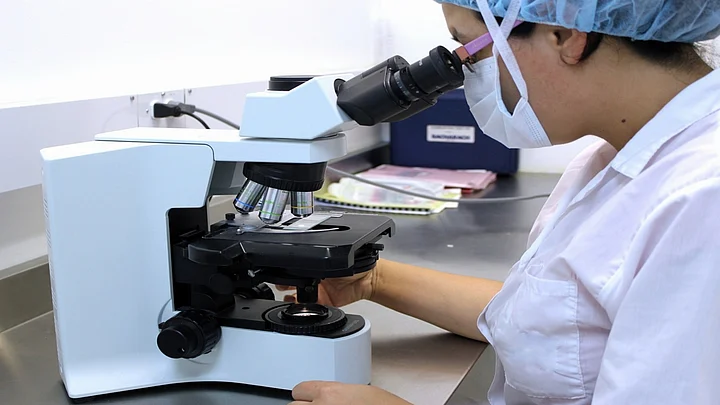Ipamorelin and Tesamorelin are two synthetic GHRPs (growth hormone-releasing peptides) gaining attention in recent biochemical studies. These peptides can activate the ghrelin receptor, potentially increasing the body's own growth hormone production. This unique impact has sparked interest in the scientific community, prompting numerous studies to explore the molecular processes and properties of these peptides.
Researchers have studied Tesamorelin to understand its potential in metabolic issues, especially in conditions like HIV-associated Lipodystrophy. On the other hand, Ipamorelin has shown potential in various studies, including those related to obesity and promoting growth.
This introduction explores the science of Tesamorelin and Ipamorelin and discusses what research has found about how they might work together. It emphasizes the need for more studies to understand the potential impact of these compounds.
Tesamorelin Peptide
Tesamorelin is a synthetic peptide having a well-defined amino acid sequence. It's a chain of 44 amino acids, which seems to work by causing the pituitary gland to secrete growth hormone (GH).
Scientists have explored conditions such as HIV-associated Lipodystrophy and age-related GH reduction to understand how Tesamorelin might impact them. While its potential to increase GH secretion is intriguing for various health issues, further research is needed to confirm these hypotheses.
Ipamorelin Peptide
Ipamorelin is a synthetic peptide first discovered as a member of the GHRP family of peptides. Alanine, glutamine, histidine, leucine, and arginine are the five amino acids that make up its chemical structure. This sequence gives Ipamorelin the potential to be a strong GH secretagogue, capable of increasing GH release by activating the ghrelin receptor. Ipamorelin is noteworthy for studying GH control because it shows selective action with minimal influence on other hormones, unlike some other GHRPs.
Mechanism of Action: Tesamorelin Peptide
Studies suggest that Tesamorelin's potential physiological impact seems to be mediated by stimulating anterior pituitary growth hormone-releasing hormone (GHRH) receptors. GH production and release into the circulation are considered to be stimulated as a result of this activation. After that, GH seems to exercise its multiple activities on several cell types, including hepatocytes, producing insulin-like growth factor-1 (IGF-1). Like GH, IGF-1 is thought to be essential for various cellular processes, including growth stimulation, suppression of apoptosis, control of glucose levels, and accelerated fat breakdown.
Research models of HIV-associated Lipodystrophy generally show low levels of GH and IGF-1, as suggested by the results of many studies. Research suggests that Tesamorelin may have the potential to restore equilibrium by controlling lipid metabolism and accumulation.
Tesamorelin's structural change at the N-terminus, distinguishing it from natural GHRH, is an interesting feature. Researchers speculate that this structural change may confer more resistance to enzyme deactivation and may improve peptide stability.
Mechanism of Action: Ipamorelin Peptide
Ipamorelin is a novel synthetic growth hormone secretagogue that seems to work by stimulating GH synthesis. Findings imply that it may maintain normal hormone levels by stimulating the anterior pituitary gland to produce growth hormone.
The pituitary receptors for GHRP seem to be the target of this peptide's extraordinary selectivity. Investigations purport that Ipamorelin may promote the growth hormone release, hGH, by acting as a GHRP receptor agonist.
Tesamorelin and Ipamorelin Peptide Blend and Growth Hormone
Findings imply that the synergistic impact may be possible in growth hormone insufficiency due to the combination of Tesamorelin and Ipamorelin, which have been suggested by researchers to display a complex mode of action.
Researchers have proposed a dual-action strategy, including the simultaneous presentation of Tesamorelin and Ipamorelin. Tesamorelin seems to boost GH secretion by activating GHRH receptors, whereas Ipamorelin appears to increase GH secretion by directly stimulating GHSR (growth hormone secretagogue-receptor). This synergistic impact is thought to increase GH response, which may have the potential for enhancing lean body mass, lipid profiles, insulin sensitivity, and metabolic function.
It has been hypothesized that Tesamorelin and Ipamorelin may improve pituitary gland activity that may eventually enhance the release of endogenous growth hormone by targeting separate components of the growth hormone axis via their respective methods.
Tesamorelin and Ipamorelin Peptide Blend and Lipodystrophy
Insulin resistance, dyslipidemia, and an increased risk for cardiovascular problems are often noted in research models of Lipodystrophy. Experimental studies have suggested that giving Tesamorelin to study models with Lipodystrophy may improve insulin sensitivity and lipid profiles and decrease VAT significantly.
Scientists propose that Tesamorelin may promote endogenous growth hormone production and facilitate lipolysis by activating the GHRHR (growth hormone-releasing hormone receptor). This suggests that Tesamorelin may have a role in maintaining subcutaneous fatty tissue in the abdomen area and the induction of positive changes in lipid metabolism.
Similarly, Ipamorelin has been suggested to host potential in controlling the metabolic activity of adipose tissue. It is hypothesized that synergistic impacts may occur when Tesamorelin and Ipamorelin are used together, which might further enhance the decrease of VAT and improve metabolic indices in models of Lipodystrophy.
Tesamorelin & Ipamorelin blend for sale is available at Core Peptides for scientists interested in further studying these compounds and their potential synergistic impact.
